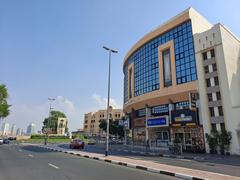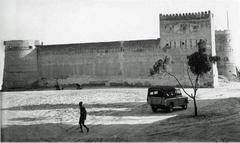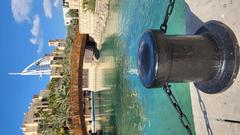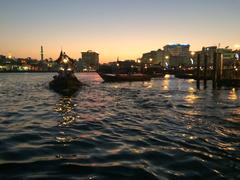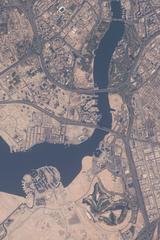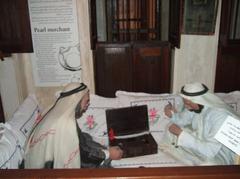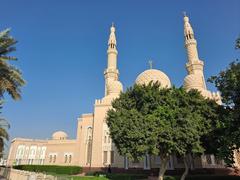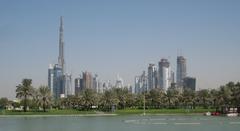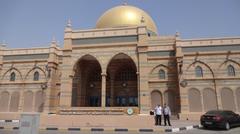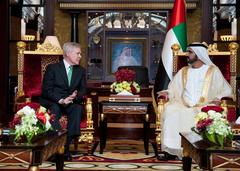Grand Mosque Dubai: Visiting Hours, Tickets, and Travel Guide
Date: 14/06/2025
Introduction
The Grand Mosque Dubai, located in the historic heart of Bur Dubai, stands as a testament to the city’s Islamic heritage, architectural splendor, and vibrant community life. Established in 1900—when Dubai was still a modest fishing and trading port—the mosque has grown alongside the city, evolving into a prominent cultural and religious landmark (Khaleej Times). With its soaring 70-meter minaret—the tallest in Dubai—and a harmonious blend of traditional and contemporary architecture, the Grand Mosque offers visitors a unique window into the spiritual and cultural fabric of the United Arab Emirates. Through guided tours, inclusive community programs, and open-door policies, the mosque fosters intercultural understanding and welcomes people from all walks of life.
This comprehensive guide covers the Grand Mosque’s history, architectural features, cultural significance, visiting hours, ticketing, etiquette, and practical travel tips, ensuring a respectful and enriching experience for every visitor.
Table of Contents
- History and Origins
- Architectural Evolution
- Cultural and Religious Significance
- Visitor Information
- Travel Tips and Nearby Attractions
- Key Architectural Features
- Preservation and Modern Relevance
- Frequently Asked Questions (FAQ)
- Visuals and Media Suggestions
- Related Articles
- Conclusion and Visitor Tips
- References
History and Origins
Established in 1900 as a kuttab (Quranic school), the Grand Mosque originally served as a center for Islamic learning and prayer in the burgeoning settlement of Dubai. Its strategic location near Dubai Creek and the textile souk made it a focal point for traders, residents, and travelers. Over the decades, the mosque has not only provided a spiritual haven but has also been a hub for social and educational activities (Khaleej Times).
Architectural Evolution
Original Structure
The Grand Mosque’s first structure was a simple building with a modest prayer hall, an open courtyard, and basic ablution facilities, utilizing local materials like coral stone, gypsum, and palm fronds. This design reflected the pragmatic and climate-adaptive architecture of the early 20th-century Gulf region.
Major Renovations
The mosque underwent significant transformations in 1960 and again in 1998. The 1960 rebuild introduced a larger, more elaborate structure incorporating domes, arches, and a minaret styled after Anatolian lighthouses. The 1998 restoration aimed to preserve historical character while integrating modern amenities and sustainable features (Dubai Travel Planner).
Interior and Capacity
The prayer hall can accommodate up to 1,200 worshippers, arranged in 23 rows. Nine large domes and 45 smaller domes crown the roof, while over 50 pillars—designed to resemble traditional wind towers—support the structure and aid in natural cooling. Massive arched windows provide abundant natural light, highlighting intricate Islamic calligraphy and geometric patterns (Khaleej Times).
Cultural and Religious Significance
Community Role
The Grand Mosque remains central to Dubai’s religious life, hosting daily prayers, Friday congregations, and major festivals such as Ramadan and Eid. It also serves as a venue for Quranic education, community gatherings, and charitable works—reinforcing its role as a cornerstone of local culture (Dubai Travel Planner).
Promoting Intercultural Understanding
Through regular guided tours and educational programs, the Grand Mosque actively fosters intercultural dialogue. Visitors are introduced to Islamic beliefs, practices, and the mosque’s history, promoting mutual respect and dispelling misconceptions about Islam (Focus HiDubai). The mosque’s proximity to other religious sites, such as the nearby Hindu temple, underscores Dubai’s tradition of religious coexistence (Focus HiDubai).
Visitor Information
Visiting Hours
- Public Visiting Hours: Saturday to Thursday, 8:00 AM – 12:00 PM and 4:00 PM – 8:00 PM.
- Guided Tours for Non-Muslims: Sunday to Thursday, 9:15 AM – 11:30 AM (organized by the Dar Al Ber Society).
- Note: The mosque is closed to tourists during prayer times and on Fridays. During Ramadan and religious festivals, visiting hours may be limited; check ahead for updates.
Tickets and Entry
- Entry Fee: Free for all visitors. Donations are welcome to support preservation and educational efforts (UAEstories).
- Access: Non-Muslims can only enter during guided tours; independent visits inside the mosque are not permitted.
Dress Code and Etiquette
- Modest clothing covering arms and legs is required for all visitors.
- Women must cover their hair with a scarf. Since the COVID-19 pandemic, the mosque does not provide abayas or scarves; visitors should bring their own or purchase them at the mosque’s bazaar.
- Shoes must be removed before entering the prayer hall.
- Maintain silence and respect; photography is allowed in designated areas but avoid disturbing worshippers.
Guided Tours and Accessibility
- Guided Tours: Offered in multiple languages by the Dar Al Ber Society and Sheikh Mohammed Centre for Cultural Understanding. Tours include insights into Islamic beliefs, architecture, and community traditions.
- Accessibility: The mosque is wheelchair accessible, with ramps and designated prayer areas for visitors with disabilities. Staff are available to assist as needed (Focus HiDubai).
Travel Tips and Nearby Attractions
- Transport: The mosque is easily accessible via Al Fahidi Metro Station (10-minute walk), taxis, and ride-hailing services.
- Best Time to Visit: Early morning or late afternoon for cooler temperatures and softer lighting.
- Nearby Attractions:
- Dubai Museum: Housed in Al Fahidi Fort, offering a journey through Dubai’s past.
- Al Fahidi Historical Neighborhood: Explore traditional Emirati architecture, galleries, and cafes.
- Dubai Creek: Enjoy traditional abra boat rides and vibrant street life.
- Textile Souk: A bustling market for fabrics and souvenirs.
- Jumeirah Mosque: Another iconic mosque offering guided tours for non-Muslim visitors (Dubai.it).
- Visitor Tips: Arrive early, bring your own scarf/abaya, and respect all posted guidelines.
Key Architectural Features
- Minaret: At 70 meters, Dubai’s tallest, designed in the Anatolian style and resembling a lighthouse—a symbol of spiritual guidance.
- Domes: Fifty-four in total (nine large, 45 smaller), symbolizing the vault of heaven and unity.
- Pillars and Wind Towers: Over 50 pillars designed after traditional wind towers (barjeel) for natural cooling and ventilation.
- Decorative Elements: Intricate Quranic calligraphy, geometric patterns, and stained glass windows diffuse natural light, creating a serene ambiance.
- Entrance: The main entrance features columns inscribed with Quranic verses, representing the Five Pillars of Islam.
Preservation and Modern Relevance
The Grand Mosque is a preserved heritage site, thanks to continuous restoration led by local government and heritage organizations. These efforts maintain the mosque’s architectural integrity while integrating modern amenities and sustainable technologies (Mala.ae). The mosque regularly organizes educational programs, interfaith dialogues, and community events, strengthening its role as both a spiritual sanctuary and a center for cultural exchange (Damac Properties).
Frequently Asked Questions (FAQ)
Q: What are the visiting hours for the Grand Mosque Dubai?
A: Guided tours for non-Muslims are available Sunday to Thursday from 9:15 AM to 11:30 AM. General visiting hours are Saturday to Thursday, 8:00 AM – 12:00 PM and 4:00 PM – 8:00 PM.
Q: Is there an entry fee?
A: Entry and guided tours are free. Donations are welcome.
Q: Can non-Muslims enter the mosque?
A: Yes, but only during official guided tours.
Q: What is the dress code?
A: Modest attire covering arms and legs is required; women must cover their hair.
Q: Is photography allowed?
A: Yes, but avoid photographing worshippers and always ask your guide for specific rules.
Q: Is the mosque accessible for visitors with disabilities?
A: Yes, the mosque is wheelchair accessible and staff are available to assist.
Visuals and Media Suggestions
- High-resolution images of the mosque’s minaret, domes, stained glass windows, and prayer hall (e.g., “Grand Mosque Dubai minaret at sunset,” “Interior prayer hall of Grand Mosque Dubai”).
- Interactive maps showing the location of the Grand Mosque and nearby attractions.
- Virtual tour links if available.
Related Articles
Conclusion and Visitor Tips
The Grand Mosque Dubai stands as a living symbol of faith, heritage, and hospitality in the heart of one of the world’s most dynamic cities. Its open-door approach, rich architectural legacy, and commitment to education and intercultural dialogue make it a must-visit for worshippers, history enthusiasts, and travelers alike. Plan your visit by checking current hours and dress guidelines, and consider joining a guided tour for the most insightful experience.
For up-to-date information, guided tour bookings, and Dubai travel inspiration, download the Audiala app and follow our social media channels. Embrace curiosity and respect, and your visit to the Grand Mosque Dubai will be both memorable and meaningful.
References
- This is a sample text. (Khaleej Times)
- This is a sample text. (Dubai Travel Planner)
- This is a sample text. (Focus HiDubai)
- This is a sample text. (UAEstories)
- This is a sample text. (Damac Properties)
- This is a sample text. (Mala.ae)
- This is a sample text. (Dubai.it)
- This is a sample text. (TravelTriangle)
